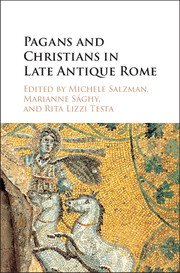 Pagans and Christians in Late Antique Rome
Pagans and Christians in Late Antique Rome Book contents
- Frontmatter
- Contents
- List of Illustrations
- Biographies of Authors
- Acknowledgments
- Introduction
- Part I SENATORIAL POLITICS AND RELIGIOUS CONFLICT
- 1 Constantine and the Roman Senate: Conflict, Cooperation, and Concealed Resistance
- 2 Beyond Pagans and Christians: Politics and Intra-Christian Conflict in the Controversy over the altar of Victory
- 3 Were Pagans Afraid to Speak Their Minds in a Christian World? The Correspondence of Symmachus
- Part II The Construction of New Religious Identities
- Part III Pagans and Christians: Coexistence and Competition
- Section A Pagans and Religious Practices in Christian Rome
- Section B Death and the Afterlife
- Section C Reading Religious Iconography as Evidence for Pagan–Christian Relations
- Concluding Remarks: Vrbs Roma between Pagans and Christians
- Index
- References
3 - Were Pagans Afraid to Speak Their Minds in a Christian World? The Correspondence of Symmachus
from Part I - SENATORIAL POLITICS AND RELIGIOUS CONFLICT
Published online by Cambridge University Press: 05 November 2015
- Frontmatter
- Contents
- List of Illustrations
- Biographies of Authors
- Acknowledgments
- Introduction
- Part I SENATORIAL POLITICS AND RELIGIOUS CONFLICT
- 1 Constantine and the Roman Senate: Conflict, Cooperation, and Concealed Resistance
- 2 Beyond Pagans and Christians: Politics and Intra-Christian Conflict in the Controversy over the altar of Victory
- 3 Were Pagans Afraid to Speak Their Minds in a Christian World? The Correspondence of Symmachus
- Part II The Construction of New Religious Identities
- Part III Pagans and Christians: Coexistence and Competition
- Section A Pagans and Religious Practices in Christian Rome
- Section B Death and the Afterlife
- Section C Reading Religious Iconography as Evidence for Pagan–Christian Relations
- Concluding Remarks: Vrbs Roma between Pagans and Christians
- Index
- References
Summary
A once popular game enjoying something of a revival of late is identifying covert anti-Christian polemic in pagan texts of late antiquity. The polemic is always covert because it is assumed that pagans were afraid to express pagan views openly. But this is pure assumption, for which no real evidence has ever been produced. Of course, direct attack or scurrilous abuse would have been imprudent, but up to the Theodosian age at any rate courteous debate and disagreement were certainly tolerated (for example, Volusianus's letter to Augustine questioning the virgin birth). A recent book by Stéphane Ratti is the first systematic attempt to document this supposed pagan fear, going so far as to maintain that already by the late fourth century pagans were afraid to reveal their paganism in their private letters. Because so many private letters survive from the fourth and fifth centuries, both pagan and Christian, this is a hypothesis that can be tested.
The letters of Q. Aurelius Symmachus cos. 391 might seem a promising target. A well-known pagan himself, Symmachus corresponded with Vettius Agorius Praetextatus and both the Nicomachi Flaviani, the most notorious pagans of the age. His more than 900 letters might be expected to contain a trove of information about the last days of Roman paganism. Yet if the 390s saw a pagan revival, Symmachus's letters reveal little hint of it.
Scholars used to assume that this is because they were edited after his death by his son Memmius Symmachus, to protect both himself and his father's reputation. Ratti has argued that the explanation for their lack of pagan content is self-censorship by Symmachus himself, afraid to speak his mind. Both explanations might seem reasonable but find little support in the letters themselves. The question has in fact been surprisingly little studied. What follows is an attempt to dig somewhat deeper than has been done hitherto.
II
It is true that, if Symmachus wrote to (or about) the supposedly pro-pagan Eugenius or Arbogast during the period of their rebellion against Theodosius, no such letters were included. But even if they had been pro-pagan, that would have been irrelevant to Symmachus's paganism. Anyone, pagan or Christian, who had written to (or about) a usurper would take care to destroy all such correspondence on the usurper's fall. There are no letters to the Christian usurper Magnus Maximus either.
- Type
- Chapter
- Information
- Pagans and Christians in Late Antique RomeConflict, Competition, and Coexistence in the Fourth Century, pp. 64 - 112Publisher: Cambridge University PressPrint publication year: 2015
References
- 1
- Cited by


